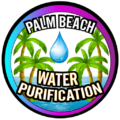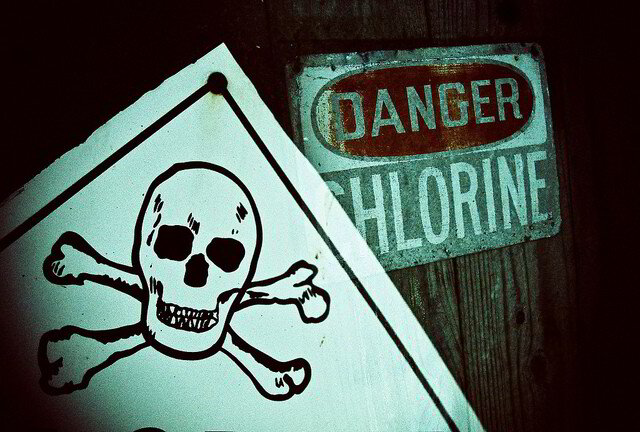Many municipalities add chlorine to their water to kill viruses and bacteria that could make us sick if we ingested them. People started adding chlorine to water in the 1800s, when they realized it had disinfectant properties. During that time, when water was left untreated, it was common for people to contract waterborne diseases such as cholera, typhoid, and dysentery. The initial introduction of chlorine as a disinfectant helped to lower disease rates.
We now know there are other ways to treat bacteria in water, such as with water purification systems. However, chlorine treatment is still the most cost-effective option for large-scale treatment, so the practice of municipalities adding chlorine to water to kill microorganisms continues. Chloramine is also used by some municipalities and produces its own negative effects.
Even though diluted chlorine is non-toxic, it can still have harmful effects, which we’ll discuss below. Additionally, chlorine treatment does not guarantee that drinking water contains zero harmful microorganisms — some may develop resistance to chlorine treatment.
Ingesting chlorine with your tap water can have a number of adverse health effects. Some of these effects occur because chlorine tends to form trihalomethanes. Trihalomethanes (THMs), including chloroform, form when chlorine reacts with tiny organic particles found in water. These chemical compounds have been implicated in several adverse health outcomes. Below are some of the potentially harmful effects of chlorine water:
• Asthma symptoms: One study suggests that exposure to chlorine in swimming pools is associated with increased exercise-induced asthma symptoms in swimmers, even if the swimmers have had no previous asthma symptoms, and even if the chlorine levels in the pool are below the recommended safe levels. When you bathe or shower in chlorinated water, you also absorb chlorine through your skin and breathe in chlorinated steam. If you experience respiratory problems, breathing in chlorine can aggravate the symptoms.
• Food allergies: One recent study analyzed the effects of dichlorophenols, which are used both in pesticides and in water chlorination. The study found that participants with the highest levels of dichlorophenols in their bodies were more likely to have the most food allergies. This study focused on dichlorophenols in pesticides, though — not in chlorinated water, though the effects may be similar.
• Birth Defects: A Taiwanese study of nearly 400,000 individuals found that women who were exposed to trihalomethanes in chlorinated water while pregnant were more likely to give birth to children with one of three different birth abnormalities: cleft palates, ventricular septal defects — or holes in the heart — and lack of brain development.
• Cancer: A 1995 study published in Environmental Health Perspectives implicated the THM byproducts of water chlorination in bladder and rectal cancer — potentially accounting for 8,000 cases of rectal cancer and 5,000 cases of bladder cancer in the United States every year. Some subsequent studies have found a link between chlorine and carcinogenic effects.
• Bad taste and smell: When your water tastes or smells bad, you’ll probably be less enthusiastic about drinking it, and drinking too little water can lead to dehydration. When your water is unpleasant to drink, you and your family are also more likely to consume less healthy beverages, such as sodas, or to purchase bottled water, which causes many other health issues.
The risk of developing cancer is 93% higher in people who drink or are otherwise exposed to chlorinated water? Chlorine is a potential health hazard to both children and adults, and it is an issue that should be taken quite seriously.
According to a Belgian study that was released in 2003, certain irritants called trichloramines are released any time chlorinated water reacts with organic materials (such as sweat or urine) from people. Trichloramines are believed to initiate a biological process that effectively destroys the cellular barriers surrounding the lungs.
Children exposed to large amounts of chlorine could potentially suffer asthmatic attacks. In one research study, rats exposed to chlorine and chloramines developed tumors in their kidneys and intestines.
Chlorine can irritate severely, even burn, skin exposed directly to it. It can irritate and burn the eyes and throat as well.
Chlorine, Cancer, and Heart Disease
“We are quite convinced, based on this study, that there is an association between cancer and chlorinated water.” ‐ Medical College of Wisconsin research team
The addition of chlorine to our drinking water began in the late 1800s and by 1904 was the standard in water treatment, and for the most part remains so today. We don’t use chlorine because it’s the safest or even the most effective means of disinfection, we use it because it is the cheapest. In spite of all our technological advances, we essentially still pour bleach in our water before we drink it. The long term effects of chlorinated drinking water have just recently being recognized. According to the U.S. Council Of Environmental Quality,
“Cancer risk among people drinking chlorinated water is 93% higher than among those whose water does not contain chlorine.”
Dr. Joseph Price wrote a highly controversial book in the late sixties titled Coronaries/Cholesterol/Chlorine and concluded that nothing can negate the incontrovertible fact, the basic cause of atherosclerosis and resulting entities such as heart attacks and stroke, is chlorine.” Dr. Price later headed up a study using chickens as test subjects, where two groups of several hundred birds were observed throughout their span to maturity. One group was given water with chlorine and the other without. The group raised with chlorine, when autopsied, showed some level of heart or circulatory disease in every specimen, the group without had no incidence of disease. The group with chlorine under winter conditions, showed outward signs of poor circulation, shivering, drooped feathers and a reduced level of activity. The group without chlorine grew faster, larger and displayed vigorous health. This study was well received in the poultry industry and is still used as a reference today. As a result, most large poultry producers use dechlorinated water. It would be a common sense conclusion that if regular chlorinated tap water is not good enough for the chickens, then it probably is not good enough for us humans!
There is a lot of concern about chlorine. When chlorine is added to our water, it combines with other natural compounds to form Trihalomethanes (chlorination byproducts), or THMs. These chlorine byproducts trigger the production of free radicals in the body, causing cell damage, and are highly carcinogenic. “Although concentrations of these carcinogens (THMs) are low, it is precisely these low levels that cancer scientists believe are responsible for the majority of human cancers in the United States“. The Environmental Defense Fund
Simply stated chlorine is a pesticide, as defined by the U.S. EPA, whose sole purpose is to kill living organisms. When we consume water containing chlorine, it kills some part of us, destroying cells and tissue inside our body. Dr. Robert Carlson, a highly respected University of Minnesota researcher whose work is sponsored by the Federal Environmental Protection Agency, sums it up by claiming , “the chlorine problem is similar to that of air pollution”, and adds that “chlorine is the greatest crippler and killer of modern times!”
Breast cancer, which now affects one in every eight women in North America, has recently been linked to the accumulation of chlorine compounds in the breast tissue. A study carried out in Hartford Connecticut, the first of its kind in North America, found that, “women with breast cancer have 50% to 60% higher levels of organochlorines (chlorination byproducts) in their breast tissue than women without breast cancer.”
One of the most shocking components to all of these studies is that up to 2/3s of our harmful exposure to chlorine is due to inhalation of steam and skin absorption while showering. A warm shower opens up the pores of the skin and allows for accelerated absorption of chlorine and other chemicals in water. The steam we inhale while showering can contain up to 50 times the level of chemicals than tap water due to the fact that chlorine and most other contaminants vaporize much faster and at a lower temperature than water. Inhalation is a much more harmful means of exposure since the chlorine gas (chloroform) we inhale goes directly into our blood stream. When we drink contaminated water the toxins are partially filtered out by our kidneys and digestive system. Chlorine vapors are known to be a strong irritant to the sensitive tissue and bronchial passages inside our lungs, it was used as a chemical weapon in World War II. The inhalation of chlorine is a suspected cause of asthma and bronchitis, especially in children… which has increased 300% in the last two decades. “Showering is suspected as the primary cause of elevated levels of chloroform in nearly every home because of chlorine in the water.” Dr Lance Wallace, U.S. Environmental Protection Agency.
Chlorine in shower water also has a very negative cosmetic effect, robbing our skin and hair of moisture and elasticity, resulting in a less vibrant and youthful appearance. Anyone who has ever swam in a chlorinated pool can relate to the harsh effects that chlorine has on the skin and hair. What’s surprising is that we commonly find higher levels of chlorine in our tap water than is recommended safe for swimming pools.
Aside from all the health risks related to chlorine in our water, it is the primary cause of bad taste and odor in drinking water. The objectionable taste causes many people to turn to other less healthful beverages like soft drinks, tea or other sweetened drinks. A decreased intake of water, for any reason, can only result in a lower degree of health.
The good news is that chlorine is one of the easiest substances to remove from our water. For that reason it logically should serve its purpose of keeping our water free from harmful bacteria and water borne diseases right up to the time of consumption, where it should then be removed by a water purification system.
It is clear that chlorine represents a very real and serious threat to our health and should be removed in our homes, at the point of use, both from the water we drink and the water we shower in.

